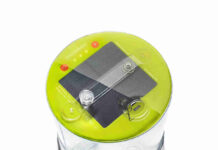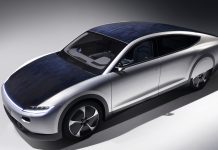
All in one: A new electricity generating building component is being developed at EPFL
Most modern buildings are composed of several layers of materials, each with its own important function: the concrete core supports its weight; the insulation regulates its heat exchange; the facade contributes to its aesthetics. Now, engineers at EPFL are developing a single building block that does all of that, and produces electricity. This new component will provide a sleek alternative to traditional construction materials, and will be lighter, safer, and more energy efficient.
“We use a composite sandwich construction to make this multi-functional building element,” explains Thomas Keller of the Composite Construction Laboratory (CCLab). The sandwich comprises a dense foam interior encased between layers of glass-fibre reinforced polymer. “We started working on these composite materials over 10 years ago and used them in 2009 for the roof of the Main Entrance Building at the Novartis Campus in Basel, Switzerland,” he says.
That was before trying to add electricity generation to the mix. “Now our goal is to encapsulate a thin flexible sheet of photovoltaic cells beneath a translucent layer of glass fiber reinforced polymer,” he continues. If they succeed, this material could contribute to making solar panels more attractive to architects by offering them more flexibility than traditional construction materials based on reinforced concrete, rigid solar panels, and glass.
The solar cell technology comes from Flexcell, an EPFL startup that became famous for its flexible sheets of photovoltaic cells, as thin as a sheet of paper. Despite lower efficiencies than conventional photovoltaic cells, their light weight, small volume, and low production costs make them ideal for encapsulation into building elements. And the ease of fitting curved surfaces with them will open new avenues in sustainable architectural design.
On top of that there are the other, already demonstrated advantages of these lightweight sandwich components. Prefabrication means that they can be assembled in a factory under ideal conditions before being transported to the construction site, increasing the quality and the safety of the buildings and shortening construction times. And since they are modular, individual elements are easy to repair or to replace if they fail.
Perfecting the ingredients
The glass fiber reinforced polymer (GFRP) plays a double role in this sandwich. A layer of GFRP a few millimeters thick encases the foam core, giving the building block its remarkable stability. Another layer of it encapsulates and protects the solar cells, drawing on an interesting optical property of the GFRP: when applied thinly, it is almost as transparent as glass, with an optical transmittance only four percent lower. Currently, a PhD student at the CCLab is perfecting this layer’s thickness to find the best compromise between structural stability and optical translucence.
“Besides the optical issues,” says Keller, “we are dealing with temperature related issues. Heating the resin leads to a loss of efficiency in light transmission. Beyond a certain critical temperature, the material could degrade and fail to recover its original state when it cools down.” But so far it has withstood temperatures beyond those expected even in the hotter parts of the world, without showing signs of degradation.
Not yet two years in to the project, the scientists involved are optimistic. Solar electricity generation is here to stay, and considering the widespread use of curved concrete surfaces in contemporary architecture, there could be great potential for this new solar sandwich.



